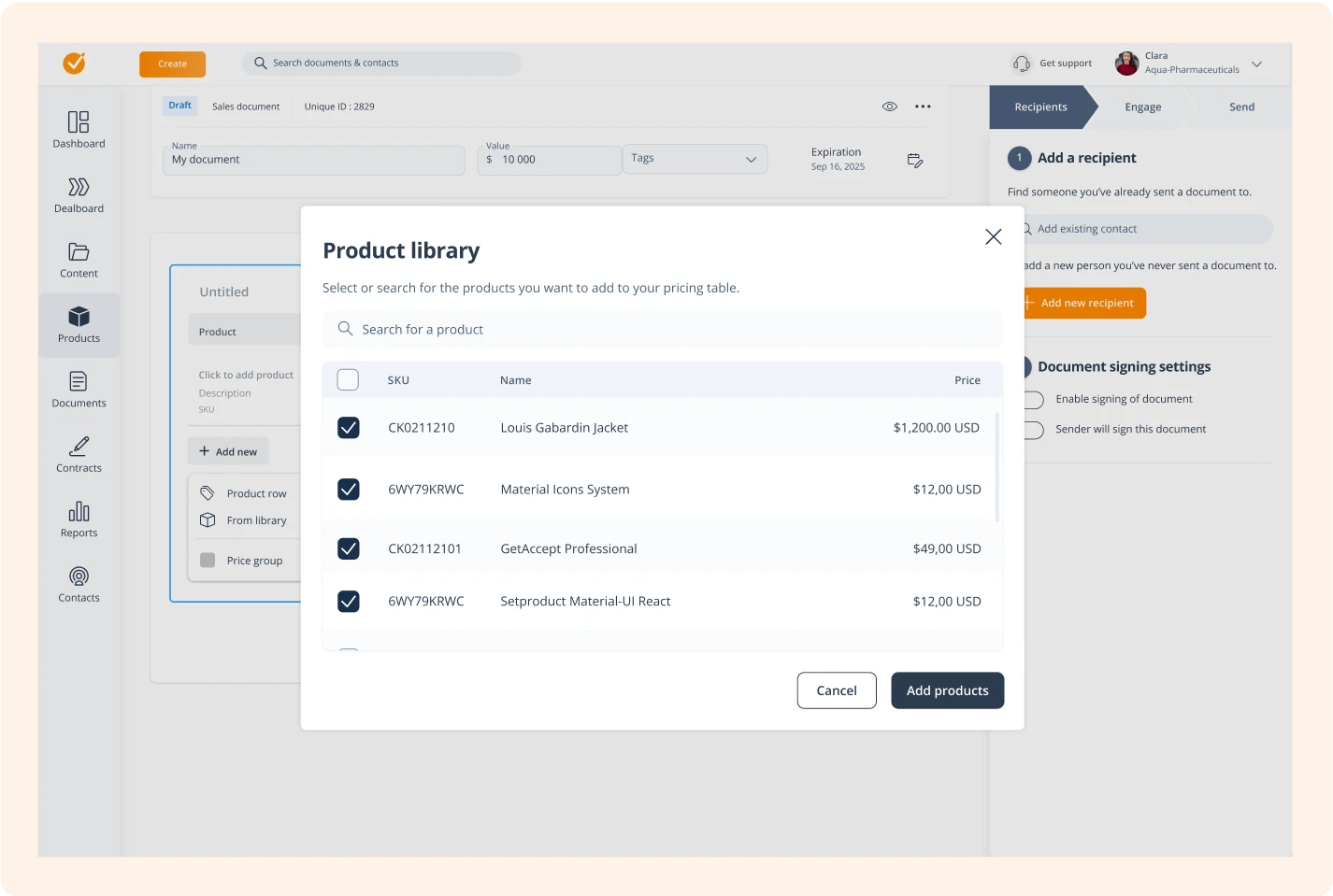Do you want to write a project proposal that stands out from the competition and help you win more business?
We’ll help you.
The average win rate for project proposals as part of RFPs stands at just 45%.
That reads pretty low to us.
And poor proposal management costs sales teams more than $800,000 per year.
In this article, we’ll share our knowledge and insights to help you create better business proposals and close more deals.
Project proposals in context
A project proposal is a document designed to ‘sell’ your project to stakeholders.
The proposal will outline everything included in your project and how it will be run, helping to convince decision-makers of its merits and feasibility.
This includes – but is not limited to – scope, pricing, timelines, background information, goals and objectives, and more.
Aren’t proposals just for sales teams?
You might think project proposals are only tied to sales and winning new business.
While that is true, there are 4 specific reasons you might want to consider submitting a project proposal:
- To help win new business
- To propose a change for an existing customer
- To get everyone on the same page ahead of a new project
- To propose change within your own organization
Because each situation is different, there’s no set “frequency” for when you should send a proposal.
That being said, here are a few scenarios where you might want to write and send a proposal:
| Solicited | Send it with an RFP as part of a major pitch to win new business. |
| Unsolicited | No one has specifically asked for it, but you send it speculatively. |
| Informal | When your client asks for more information on a potential project. |
| Renewal | Sent to renew an existing relationship/project, e.g. phase two. |
| Continuation | A great way to summarize information for an already agreed project. |
| Supplemental | To expand the scope/budget/timeline of an existing project. |
8 considerations to include in your next proposal
A project proposal doesn’t have to be hundreds of pages long and difficult to read. But it does have to be informative and thorough if you want it to succeed.
Depending on the scale of your project, you could summarize everything in 3 or 4 pages. However, the bigger the project, the more information you'll need to include in your proposal.
We’ve outlined eight key sections you should consider including in your next project proposal to give you the best chance of success – starting with the basics.
1. Introductory information
To set the scene for the project, you’ll need to include a number introductory details, such as:
- Project name: Call it something relevant, like ‘Implementation project for X,’ rather than a cliched name like ‘Project Zeus.’
- Customer: Include the name of the customer’s company – or department if it’s an internal project.
- Date: This is the commencement date for the project, not today’s date.
- Project manager: Give the name, position, and company of the person in charge of the project.
- Customer lead: List who the key contact will be on the client side – if you know.
- Document version number: This will typically be controlled using a version number like v1.1. This helps to ensure everyone is looking at the latest version. It can be especially useful once you’ve sought customer feedback and made edits/adjustments.
| Note: If you're using proposal software like GetAccept, there's no need to include a document version number. This is because the proposal is a living, breathing live document that can be updated in real time. And anytime it is updated, anybody with access will automatically be made aware of any changes. |
2. Project background
With the basics out of the way, it’s now time to add details about the project.
One of the first things you should do is communicate clearly that you understand the client’s needs.
By outlining the background of this project, you can help establish trust between you and the client that you can solve their problems.
Three elements you should include in this section are:
- About the customer: Craft a short description of who they are, what they do, etc.
- Current state: To the best of your understanding, what current solution is in place?
- Business drivers: What are the pain points or specific needs for change that have brought about this project?
Having this information in place will help add weight to the approach you’ll be suggesting throughout the rest of your proposal.
3. Project fundamentals
After establishing the background of the project, you’ll need to outline some of the more specific fundamentals and what a decision-maker can expect.
This helps stakeholders understand why they should undertake this project and what outcomes are likely to result.
Typical project fundamentals that you should address in your proposal include:
- Project purpose: What is the aim of the project? Why is it happening?
- Goals: What are the long-term outcomes you’re aiming to achieve following this project? For example, ‘improving customer experience.’
- Objectives: What short-term outcomes will you secure by undertaking this project? This is a great place to highlight what you’ll specifically achieve, e.g., ‘Win rates.’
- Measuring success: How will you know the project has achieved its goal? What measures/KPIs/targets will you implement to help monitor this?
- Assumptions and Constraints: What assumed knowledge are you working with, and what potential issues, roadblocks, or limitations do you anticipate before the project starts?
4. Project scope
One of the easiest ways to derail a project or go over budget is by not having a definitive project scope that outlines exactly what is and isn’t included.
When focusing on what’s in scope, you should consider producing a short summary of the overall project deliverables and combining that with a list of specific requirements they’ll hit.
When it comes to defining what is out of scope - or to be excluded from the project - you can simply list specific items, deliverables, or requirements that will not be included.
5. Project timeline
Decision-makers will consider three key aspects when approving or vetoing a project:
- Cost
- Quality
- Time
Timelines matter because no one wants to wait any longer than necessary to experience the benefits the project will bring them.
In your proposal, you should summarize the timeline by suggesting at a high level how many days, weeks, or months the project will take.
Then, for larger projects, you should consider using a work breakdown structure table to illustrate exactly what is involved in each part of the project.
| Area | Duration | Start | End | Responsible |
| Work type | ||||
| Deliverable one | 1 day | TBC | TBC | Big Software Ltd |
| Deliverable two | 1 day | TBC | TBC | Acme Inc. |
| Work type | ||||
| Deliverable three | 1 day | TBC | TBC | Big Software Ltd |
| Deliverable four | 1 day | TBC | TBC | Acme Inc. |
| Tip! In GetAccept, you can use our mutual action plan (MAP) feature to create a timeline like this in your project proposal document. |
6. Project details
Multiple stakeholders will read your project proposal before it’s agreed upon, and each of them is likely to be interested in different things as part of their decision-making process.
Some will only be interested in high-level information like costs or delivery schedules, whereas others will want to know all about how you plan to run the project.
This is where the project details section of your proposal can prove invaluable. It allows you to easily overcome any potential objections before they become dealbreaker issues.
The project details section should include the following to make your proposal stand out:
- Risk planning: Show that you’ve considered risks and how to mitigate them. This could include anything from scope creep to budget issues and environmental factors.
- Change management: All projects result in change for an organization. Outline how you’ll introduce that change to your customers and ensure high levels of adoption. This could include training programs, awareness campaigns, and more.
- Project controls: Discuss how your client will be informed of project progress and potential issues. Is it a weekly report? Perhaps it's project management software?
- Project comms: Demonstrate how you plan to communicate with different stakeholders in the project. Are there set meetings? Regular email updates? Or maybe all-hands calls?
- Responsibilities: You are not solely responsible for all of a project. For a project to be successful, your client needs to get involved, too. So, suggest who is responsible for what.
7. Project budget
In this section of your proposal, you will outline the costs involved in delivering the project.
Depending on the size of the project, you can format this in two ways:
For smaller projects, you can summarize pricing as a single total cost, e.g., $5,000.
For larger projects, you should consider breaking down costs into separate line items, which will look more like this:
| Phase one | |
| Project management | $4,985 |
| Resources | $7,560 |
| Phase two | |
| Equipment | $9,450 |
| Film deliverables | $15,000 |
| Total | $36,995 |
|
Tip! Using proposal software as part of your proposal process? Take advantage of tools like CPQ to help you achieve consistent and accurate pricing tables every time. |

| Are you new to proposal software? Read our introductory guide here. |
8. Signature
The last piece of any project proposal is the signature field.
You can collect a ‘wet’ signature using a pen, but it’s 2024 - no one wants to print, sign, and scan documents.
Instead, most companies use electronic signature to get their project proposals signed off quickly (and achieve a 51% higher win rate).
Once you’ve collected the digital signatures, you’re all set.
From writing a project proposal to being signed it 8 simple steps.
But we’re not quite done yet.
Let’s take a closer look at some of the do’s and don’ts of writing project proposals.
Avoid these mistakes when writing a project proposal
Writing a project proposal doesn’t have to be difficult or daunting. In fact, with the right tools in place - like proposal management software - it can become a lot easier.
That said, there are still some best practices you should consider following and some ‘not so great’ practices you should avoid.
| Do this | Don't do this |
| ✅ Stay on brand with visuals & messaging, etc. | ❌ Don't be afraid to write as many words as needed |
| ✅ Keep information consistent and accurate | ❌ Don't submit your proposal before proofing it |
| ✅ Edit based on customer feedback | ❌ Don't reinvent the wheel; reuse former proposals |
| ✅ Don't be afraid to adjust the scope to win the deal | ❌ Don't forget to personalise the proposal, though! |
| ✅ Be thorough, don't make the reader guess | ❌ Don't forget to ask for feedback from customers |
Another way to set yourself up for success when it comes to writing project proposals is to consider using a framework or template to kickstart the process for you.
Project proposal framework & templates
We’ve prepared a framework to help you start with project proposals based on the 8 considerations above. You can copy and paste the template, edit it, or adapt it to your needs.
If you’re really short on time, we have a proposal template library that you can use to access more than 50 templates covering multiple sectors, including B2B SaaS, Consulting, Media, and more.
Get started with our free proposal templates


